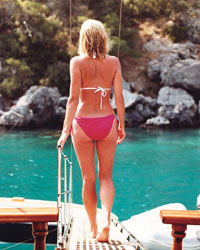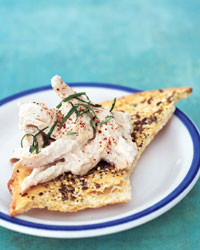
  
|
Thursday June 16, 2005
| |

|
|
|
||
Sailing Through Byzantium
I am on a Blue Voyage. It's a mysterious term, one I'd never heard a month ago. But as I stand on deck with the cobalt Aegean beneath me and the azure sky above, I can't imagine what else you would call one of these languorous sailboat trips through the coves and inlets of Turkey's southwestern coast. Blue Voyage—somehow the phrase itself feels romantic, peaceful, relaxed. On the other hand, as I glance around at this lovely boat that we're on, the Cassandra, it's very easy to imagine a more graceful word for her than gulet.
But if you're on a Blue Voyage, then you're most likely on a gulet. Gulets are traditional Turkish wooden sailboats—although these days they're often operated by tour companies, equipped with a variety of amenities such as stereos, air conditioners and cappuccino machines, and run by a crew that includes a private chef. They are gorgeous, exotic sailboats; they remind me of pirate ships or galleons. The Cassandra is 92 feet long and has three two-person cabins. Her three-man crew during my trip is Captain Ali; Bariş, the deckhand; and Gino, our energetic chef. The crew sometimes sleep on deck under the Turkish stars, and I decide that I will; the weather is too beautiful not to.
Lorrie Croze, who is also on board, is the key to all this: Her five-year-old travel company, Mediterranean Collection, was our source for the Cassandra. My friend Peter, who's lived in Istanbul for almost seven years, insisted I contact her. "I do a Blue Voyage at least once a year," he said. "Lorrie's gulets are elegant without being exorbitant, and she knows the best routes and the best cooks." She also, he said, knows more than anyone about great restaurants hidden along the coast—places you could spend months hunting for and never find on your own.
A typical Blue Voyage takes about a week. You follow the coast, cruising for a few hours each day, then swimming, snorkeling, eating and drinking the rest of the time. These trips are utterly relaxing. There's no pressure to do anything at all—how you spend your time is entirely up to you.
One thing that's clear from the moment we set sail is that a Blue Voyage is as much about what you're going to eat as about where you're going to go. No more than a couple of hours out from Bodrum, we drop anchor: time for lunch. Bariş, who doubles as our server, brings out plates of karniyarik, literally "split belly"—eggplant split and stuffed with chopped onions, green peppers, and minced lamb or beef sautéed in olive oil and mixed with tomatoes and parsley. It's rich but not heavy, impossible to resist. When I remark that Turkish cuisine doesn't seem particularly spicy, Peter corrects me. "Western Turkish," he says, and of course we are on the western coast. "Eastern Turkish uses tons of red chile peppers."
Life at sea flows effortlessly. Each morning Gino makes our breakfast, everyone sitting on deck in bathing suits. Lunches and dinners feature Turkish home-style dishes, like manti, a small ravioli filled with minced lamb or beef, in a red-pepper and tomato sauce. Helping us navigate the nuances of Turkish cuisine is Eveline Zoutendijk, a friend of Peter's who has joined us for the trip and who offers classes in Turkish cooking at Istanbul's Sarniç Hotel, which she owns. (Eveline developed the recipes for this article.) We have lunch at 2, dinner at 8 or later. Cocktails whenever. In between we swim and lie on the deck, enjoying the light and the water. "Turkish time," says Lorrie.
It seems as though no time has passed before we reach Ekincik bay, though in fact it's our third day. Aboard a flat-bottomed taxi boat, we chug up the twisting emerald-green Dalyan River, surrounded by tall tan grass. Old men in tiny, baby-blue fishing boats ignore us as they pull small blue crabs from the reeds.
Our destination is a restaurant called Yakamoz, where we eat on a wooden deck that hangs over the river in the shade of a large pomegranate tree. Opposite us rises a cliff wall into which huge tombs were carved centuries ago. We start the meal with mezes, basically Turkish tapas: acili ezme salata, a salad of crushed chiles, tomatoes and onions; crisp börek, baked tubes of phyllo filled with spices and cheese; and haydari, a thick yogurt with mint and a little garlic (the Greeks call their thinner version tzatziki and add cucumber).
And Turkish wines: After the mezes, for a massive tray of grilled lamb, beef and chicken on rice, we open a red from Kavaklidere winery, which is located in Ankara. Called Selection Kirmizi, it's a blend of two native Turkish grapes, Öküzgözü and Bogazkere. The wine is enticing, full of juicy red-currant flavors and spice notes, and its robust tannins are a good match for the grilled meats.
Our next stop, the aquamarine lagoon of Ölüdeniz, is stunning beneath towering, arid mountains, but the beach is uncomfortably rocky. Lorrie explains that most of the beaches in the area are rocky, and in fact the Turks generally prefer it that way, as they consider sand unclean. Soon she's showing me outfits for paragliding—today's activity. Is it safe? "Well, you won't get me up there!" she says cheerfully.
A 45-minute truck ride later, I'm at the top of those towering mountains, strapped into a parachute with my pilot. When he says run, I run, terrified...and there's the Cassandra, directly below my sandals, with only 3,000 feet of air separating us. "Lucky!" cries the pilot. "We are seeing clouds only three times in summer!" He spins us into a cloud, and I'm astonished: Clouds are warm.
After I land back on the beach, exhilarated, Lorrie points to a long, long flight of stone stairs. "The White Dolphin's at the top," she says. The sun is brutal, and we're sweating by the time we reach the stairs, gasping halfway up. But the work is well worth it. We dine on delicious plates of denizotu, a sea plant that has an almost Japanese flavor; ahtapot, or octopus, coarsely cut and molded into a pâté with olive oil, black pepper, dill and lemon juice; and kebabs with swordfish chunks, lemon wedges, bay leaves and long hot green peppers. Brushed with olive oil and grilled, they're distinctly smoky. For dessert, we have baklava. I'm completely uninterested. Baklava bores me. But I love this. Lorrie explains that unlike Greeks, who use honey in their baklava, Turks use boiled sugar water. It's the best baklava I've ever had, light and not at all cloying.
Later on that day we arrive at Gemiler Island, also known as St. Nicholas' Island, which is the site of the remains of Christian churches dating back to the late fifth and early sixth centuries. We clamber up a series of steep, island-size stones to a landscape full of destroyed stone churches and houses. Standing under a ruined Byzantine church dome, we glimpse a not-quite-full moon rising over the crest of a hill.
Afterward, even though the water is darkening, we decide to swim to our gulet—it's only about 600 yards. We dive in, and the sea is warm and green around us. Below us are huge cakes of stone that were once parts of ancient walls. We swim. Peter frowns. "There's a current," he says, which is when a Turkish guy in a speedboat dragging three plastic doughnuts pulls up. "We're swimming to our boat," Lorrie explains brightly. He says, "It's illegal to swim across the channel." As if on cue, another speedboat—pulling a hotshot Swedish kid on water skis—screams past. "I'll tow you back," says the guy, smiling. "Don't worry, no charge."
Somehow it's our last day. Although Lorrie warned us, we're unprepared for the emptiness of Kaya Village, which the locals also call Kayaköy. Inhabited mostly by Greek Christians during the 1800s, it was emptied during the bitter exchanges of populations between Greece and Turkey after World War I.
We pass through the mesmerizing perfume of a fig tree (I pick some of the figs and eat them), walking by empty, crumbling homes and shops. Later, exploring the island, we come across a church that still bears traces of Greek Orthodox figures, halos of gold, Christ's nailed feet disappearing into the incense-stained stone of the vault. Outside, pomegranate and pear trees bear fruit for no one.
Then it's over—almost. We leave the Cassandra in Göcek, and it's strange ending an intense week so suddenly. But Lorrie has that covered: Before I fly back to Istanbul, she'll ease me back onto land. Soon we're driving up twisting roads into the hills, above us some of the most beautiful mountains I've ever seen. Then we arrive at Yakapark.
I've never seen anything like this, anywhere: In the middle of hot, dusty, rocky mountains is an oasis, part picnic area, part casual restaurant and part trout farm. Bubbling streams rush through wooden troughs under leafy plane trees, past elevated wooden platforms and tree houses, each furnished with low tables, cushions and rugs. We are the only foreigners.
We order grilled trout (of course) and bottles of Efes, the Turkish beer. The fresh fish, served with a tangy pomegranate sauce, is simple and lovely. We devour potatoes with spices and parsley, and ispanakli gözleme, an Anatolian flat bread filled with feta cheese and spinach. Below us there's a circular bar with a tiny stream carved inside it where you can pet the trout. We pour cold water on our feet from terra-cotta jugs. The sound of water lulls us. And the moon rises through the trees, completely full.
New York-based writer Chandler Burr is the author of The Emperor of Scent: A True Story of Perfume and Obsession.
Copyright © 2005, American Express Publishing. All rights reserved.
 Try 2 Issues Free
Try 2 Issues Free

















